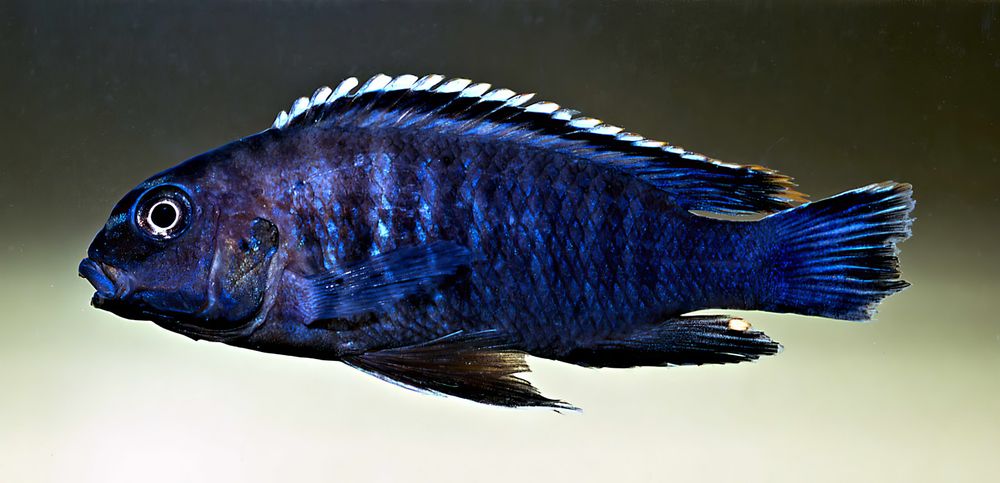That one doesn’t bother me. I’ve never heard anyone dismiss a role for human females’ nipples in nursing babies because men also have ‘em.
That one doesn’t bother me. I’ve never heard anyone dismiss a role for human females’ nipples in nursing babies because men also have ‘em.
Finally, many "haplochromine" genera (tribe Pseudocrenilabrini) remain "incertae sedis"--of uncertain position--within this tribe, and so are not included in a subtribe. Besides "serranochromines" and riverine genera mentioned in #2, the many cichlids of Lake Victoria also need more study!

Finally, many "haplochromine" genera (tribe Pseudocrenilabrini) remain "incertae sedis"--of uncertain position--within this tribe, and so are not included in a subtribe. Besides "serranochromines" and riverine genera mentioned in #2, the many cichlids of Lake Victoria also need more study!
𝗖𝘆𝗿𝘁𝗼𝗰𝗮𝗿𝗶𝗻𝗮 is my third and final new Lake Malawi subtribe. It includes all remaining endemic "haplochromines" in the lake--some 35 genera and 255 named species. Once again, someone else had proposed the same subtribe name years earlier, but had failed to satisfy all Code requirements.

𝗖𝘆𝗿𝘁𝗼𝗰𝗮𝗿𝗶𝗻𝗮 is my third and final new Lake Malawi subtribe. It includes all remaining endemic "haplochromines" in the lake--some 35 genera and 255 named species. Once again, someone else had proposed the same subtribe name years earlier, but had failed to satisfy all Code requirements.
𝗣𝘀𝗲𝘂𝗱𝗼𝘁𝗿𝗼𝗽𝗵𝗲𝗶𝗻𝗮 is the second new subtribe of Lake Malawi "haplochromines" (tribe Pseudocrenilabrini). This group is familiar to aquarists and scientists as the "mbuna." Two previous attempts by others to give them the same name (as -ini or -ina) failed to meet requirements of the Code (ICZN).

𝗣𝘀𝗲𝘂𝗱𝗼𝘁𝗿𝗼𝗽𝗵𝗲𝗶𝗻𝗮 is the second new subtribe of Lake Malawi "haplochromines" (tribe Pseudocrenilabrini). This group is familiar to aquarists and scientists as the "mbuna." Two previous attempts by others to give them the same name (as -ini or -ina) failed to meet requirements of the Code (ICZN).
Based on diagnostic morphological characters and other workers' molecular genetic characters, in my recent paper (doi.org/10.3897/BDJ....) I named three new subtribes endemic to Lake Malawi. The first is 𝗥𝗵𝗮𝗺𝗽𝗵𝗼𝗰𝗵𝗿𝗼𝗺𝗶𝗻𝗮, with 𝘙𝘩𝘢𝘮𝘱𝘩𝘰𝘤𝘩𝘳𝘰𝘮𝘪𝘴, 𝘋𝘪𝘱𝘭𝘰𝘵𝘢𝘹𝘰𝘥𝘰𝘯, and 𝘗𝘢𝘭𝘭𝘪𝘥𝘰𝘤𝘩𝘳𝘰𝘮𝘪𝘴. More info in Alt.

Based on diagnostic morphological characters and other workers' molecular genetic characters, in my recent paper (doi.org/10.3897/BDJ....) I named three new subtribes endemic to Lake Malawi. The first is 𝗥𝗵𝗮𝗺𝗽𝗵𝗼𝗰𝗵𝗿𝗼𝗺𝗶𝗻𝗮, with 𝘙𝘩𝘢𝘮𝘱𝘩𝘰𝘤𝘩𝘳𝘰𝘮𝘪𝘴, 𝘋𝘪𝘱𝘭𝘰𝘵𝘢𝘹𝘰𝘥𝘰𝘯, and 𝘗𝘢𝘭𝘭𝘪𝘥𝘰𝘤𝘩𝘳𝘰𝘮𝘪𝘴. More info in Alt.
One Lake Tanganyika cichlid tribe, the Tropheini, clearly falls within the "Haplochromini" (correctly, Pseudocrenilabrini) according to many molecular phylogenetic studies. I therefore changed its status & reassigned it to that tribe, as the subtribe 𝗧𝗿𝗼𝗽𝗵𝗲𝗶𝗻𝗮, with nine genera (see Alt text).

One Lake Tanganyika cichlid tribe, the Tropheini, clearly falls within the "Haplochromini" (correctly, Pseudocrenilabrini) according to many molecular phylogenetic studies. I therefore changed its status & reassigned it to that tribe, as the subtribe 𝗧𝗿𝗼𝗽𝗵𝗲𝗶𝗻𝗮, with nine genera (see Alt text).
One subgroup of the Pseudocrenilabrini tribe that IS apparently monophyletic, thus meriting formal subtribe status, is the 𝗣𝘀𝗲𝘂𝗱𝗼𝗰𝗿𝗲𝗻𝗶𝗹𝗮𝗯𝗿𝗶𝗻𝗮. (Notice that tribe names end in -ini whereas subtribe names end in -ina.) This subtribe includes 𝘗𝘴𝘦𝘶𝘥𝘰𝘤𝘳𝘦𝘯𝘪𝘭𝘢𝘣𝘳𝘶𝘴, 𝘓𝘶𝘧𝘶𝘣𝘶𝘤𝘩𝘳𝘰𝘮𝘪𝘴, 𝘗𝘢𝘭𝘢𝘦𝘰𝘱𝘭𝘦𝘹, & more.

One subgroup of the Pseudocrenilabrini tribe that IS apparently monophyletic, thus meriting formal subtribe status, is the 𝗣𝘀𝗲𝘂𝗱𝗼𝗰𝗿𝗲𝗻𝗶𝗹𝗮𝗯𝗿𝗶𝗻𝗮. (Notice that tribe names end in -ini whereas subtribe names end in -ina.) This subtribe includes 𝘗𝘴𝘦𝘶𝘥𝘰𝘤𝘳𝘦𝘯𝘪𝘭𝘢𝘣𝘳𝘶𝘴, 𝘓𝘶𝘧𝘶𝘣𝘶𝘤𝘩𝘳𝘰𝘮𝘪𝘴, 𝘗𝘢𝘭𝘢𝘦𝘰𝘱𝘭𝘦𝘹, & more.
"Serranochromines" are another informal subgroup of Pseudocrenilabrini that seems to be not monophyletic - so not a subtribe. It includes 𝘚𝘦𝘳𝘳𝘢𝘯𝘰𝘤𝘩𝘳𝘰𝘮𝘪𝘴, 𝘊𝘩𝘦𝘵𝘪𝘢, 𝘚𝘢𝘳𝘨𝘰𝘤𝘩𝘳𝘰𝘮𝘪𝘴, and 𝘗𝘩𝘢𝘳𝘺𝘯𝘨𝘰𝘤𝘩𝘳𝘰𝘮𝘪𝘴 and currently includes some 30 described species in the four genera. Most of these inhabit rivers.

"Serranochromines" are another informal subgroup of Pseudocrenilabrini that seems to be not monophyletic - so not a subtribe. It includes 𝘚𝘦𝘳𝘳𝘢𝘯𝘰𝘤𝘩𝘳𝘰𝘮𝘪𝘴, 𝘊𝘩𝘦𝘵𝘪𝘢, 𝘚𝘢𝘳𝘨𝘰𝘤𝘩𝘳𝘰𝘮𝘪𝘴, and 𝘗𝘩𝘢𝘳𝘺𝘯𝘨𝘰𝘤𝘩𝘳𝘰𝘮𝘪𝘴 and currently includes some 30 described species in the four genera. Most of these inhabit rivers.
The new subtribes of Pseudocrenilabrini are largely based on molecular phylogenetic work by others (credited in my paper). Not all "haplochromines" can be assigned to subtribes yet. Among these "incertae sedis" genera are 𝘖𝘳𝘵𝘩𝘰𝘤𝘩𝘳𝘰𝘮𝘪𝘴, 𝘊𝘵𝘦𝘯𝘰𝘤𝘩𝘳𝘰𝘮𝘪𝘴, and the Lake Victoria flock (see last post).
The new subtribes of Pseudocrenilabrini are largely based on molecular phylogenetic work by others (credited in my paper). Not all "haplochromines" can be assigned to subtribes yet. Among these "incertae sedis" genera are 𝘖𝘳𝘵𝘩𝘰𝘤𝘩𝘳𝘰𝘮𝘪𝘴, 𝘊𝘵𝘦𝘯𝘰𝘤𝘩𝘳𝘰𝘮𝘪𝘴, and the Lake Victoria flock (see last post).
Oh. Spindle.
Oh. Spindle.
This was a solo project (with radiographic images kindly provided by ten museums) that I've been working on for over ten years, and intensively for the last four. I also designate several new subtribes, 3 of them in Lake Malawi's flock. Sound intriguing? Have a look!
doi.org/10.3897/BDJ....
This was a solo project (with radiographic images kindly provided by ten museums) that I've been working on for over ten years, and intensively for the last four. I also designate several new subtribes, 3 of them in Lake Malawi's flock. Sound intriguing? Have a look!
doi.org/10.3897/BDJ....
I also explore the specific patterns with which the pterygiophores are situated between the neural or hemal spines of the vertebrae. I include the first cladogram to include all cichlid subfamilies, tribes, and subtribesAll raw data are provided in supporting information. …

I also explore the specific patterns with which the pterygiophores are situated between the neural or hemal spines of the vertebrae. I include the first cladogram to include all cichlid subfamilies, tribes, and subtribesAll raw data are provided in supporting information. …
Using "xrays" (radiographs) of some 1,700 specimens of almost 400 species, I survey the numbers of vertebrae, dorsal-fin and anal-fin supports (pterygiophores), and supraneural bones (small bones in the midline between the top of the skull and the first dorsal spine). …
Using "xrays" (radiographs) of some 1,700 specimens of almost 400 species, I survey the numbers of vertebrae, dorsal-fin and anal-fin supports (pterygiophores), and supraneural bones (small bones in the midline between the top of the skull and the first dorsal spine). …


